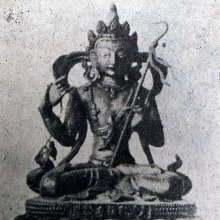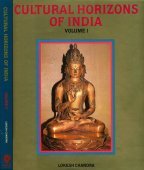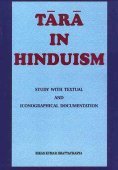Oddiyana, Oḍḍiyāna: 5 definitions
Introduction:
Oddiyana means something in Buddhism, Pali, Hinduism, Sanskrit. If you want to know the exact meaning, history, etymology or English translation of this term then check out the descriptions on this page. Add your comment or reference to a book if you want to contribute to this summary article.
Images (photo gallery)
In Hinduism
Shaivism (Shaiva philosophy)
Source: Wisdom Library: Kubjikāmata-tantraOḍḍiyāna (ओड्डियान):—The name of one of the pīthas of the Mātṛcakra, according to the Kubjikāmatatantra. The presiding goddess is Raktā (one of the four female attendant deities of Mitra, the central deity).

Shaiva (शैव, śaiva) or Shaivism (śaivism) represents a tradition of Hinduism worshiping Shiva as the supreme being. Closely related to Shaktism, Shaiva literature includes a range of scriptures, including Tantras, while the root of this tradition may be traced back to the ancient Vedas.
Shaktism (Shakta philosophy)
Source: Google Books: The Kubjikāmatatantra: Kulālikāmnāya VersionOḍḍiyāna (ओड्डियान) refers to one of the Mahāpīṭhas where Devī becomes incarnate, according to the Kubjikāmata-tantra.—After her stay on the Kaumāraparvata, Devī visits several localities e.g., Mount Trikūṭa, Mount Kiṣkindha etc., untill she reaches the Western Himagahvara. This locality and the three following—Karāla, Sahya Mahāvana, Ucchuṣmā Nadī—are identified with the four Mahāpīṭhas: Oḍḍiyāna, Jālandhara, Pūrṇagiri and Kāmarūpa. In these four places, Devī becomes incarnate as a protective goddess and future mother of many sons and daughters; a number of servants also appears at each of the four localities. During her stay in the fourth Mahāpīṭha Devī explains the fifth which is called Mātaṅga. In contradistinction to the other Pīṭhas it has no fixed location on earth, but seems to be located above Kāmarūpa. As such it is the place of origin of the entire world. [...] After her visit to the fourth Mahāpīṭha, the goddess proceeds to various other places; [...]
Source: Google Books: ManthanabhairavatantramOḍḍiyāna (ओड्डियान) (or Uḍḍiyāna, Oḍḍiyānaka) refers to a Mahāpīṭha (main sacred seat) and one of the ten places visited by the Goddess on her pilgrimage, according to Tantric texts such as the Kubjikāmata-tantra, the earliest popular and most authoritative Tantra of the Kubjikā cult.—Accordingly, “[...] Then content and profound, Kujeśvarī who is endowed with the quality of discernment and whose creation (takes place) by many means said this: “As (I) have flown up (oḍḍitā) (here) within Oḍḍīśa, therefore this (place will be known) as Oḍḍiyānaka”.
The (name) Oḍḍiyāna is appropriately applied because the Śakti of the residents of this Pīṭha is seen to be very, i.e. permanently, “in ascent” (uḍḍīnā, i.e. vibrant)'. Clearly, according to the Kālīkrama, it is the goddess, not the Siddha of this seat, who is “in ascent”. The Kumārikākhaṇḍa (42.16ab) confirms that this is the view in the Kubjikā tradition also when it explains that the name of this seat is related to the goddess who, is the energy of the vital breath and “the form of the breath is that of a bird (that flies upwards), and so (her seat) is Odyāṇaka”.

Shakta (शाक्त, śākta) or Shaktism (śāktism) represents a tradition of Hinduism where the Goddess (Devi) is revered and worshipped. Shakta literature includes a range of scriptures, including various Agamas and Tantras, although its roots may be traced back to the Vedas.
In Buddhism
Tibetan Buddhism (Vajrayana or tantric Buddhism)
Source: Wisdomlib Libary: VajrayoginiOḍḍiyāna (ओड्डियान) is the name of a sacred site (pīṭha) presided over by Prabhāvatī, according to the vārāhyabhyudaya-maṇḍala. Prabhāvatī is a deity situated in one of the six petals of the eastern lotus, of which the presiding deity is kuleśvarī (presiding lady) named Māmakī. The central deity of the vārāhyabhyudaya-maṇḍala is the twelve-armed Vajravarāhī.
Oḍḍiyāna is one of the twenty-four pīṭhas, or ‘sacred-site’ (six lotuses each having six petals), each corresponding with a part of the human body. Oḍḍiyāna is to be contemplated as situated in the right ear. Besides being associated with a bodily spot, each pīṭha represents an actual place of ancient India frequented particularly by advanced tantric practitioners

Tibetan Buddhism includes schools such as Nyingma, Kadampa, Kagyu and Gelug. Their primary canon of literature is divided in two broad categories: The Kangyur, which consists of Buddha’s words, and the Tengyur, which includes commentaries from various sources. Esotericism and tantra techniques (vajrayāna) are collected indepently.
Languages of India and abroad
Sanskrit dictionary
Source: Cologne Digital Sanskrit Dictionaries: Edgerton Buddhist Hybrid Sanskrit DictionaryOḍḍiyāna (ओड्डियान) or Uḍḍiyāna.—: Sādhanamālā 361.16.
--- OR ---
Oḍḍiyāna (ओड्डियान).—also Oḍi° (and uḍḍiyāna(ka), q.v.), name of a locality; see GOS 41 p. xxxvii; Lévi, Mahā-Māyūrī p. 105 ff.: Sādhanamālā 80.18 etc.; Oḍiyāna, Sādhanamālā 286.11 etc.; Oḍḍiyāna- (or Oḍiyāna, Sādhanamālā 283.10 etc.)-Mārīcī, a form of Mārīcī, Sādhanamālā 283.10 etc.; 287.10—11.
Sanskrit, also spelled संस्कृतम् (saṃskṛtam), is an ancient language of India commonly seen as the grandmother of the Indo-European language family (even English!). Closely allied with Prakrit and Pali, Sanskrit is more exhaustive in both grammar and terms and has the most extensive collection of literature in the world, greatly surpassing its sister-languages Greek and Latin.
See also (Relevant definitions)
Starts with: Oddiyanaka, Oddiyanapitha.
Ends with: Shryoddiyana.
Full-text (+205): Uddiyana, Padmasambhava, Oddiyanapitha, Odishi, Odamaheshvara, Karalini, Adharanatha, Udayanatha, Vrikshakrama, Uddina, Khecarihridaya, Shringataka, Hemankura, Harakhecara, Oddavva, Pranavapitha, Kumari, Vyomakranta, Devatasamketa, Raudramantra.
Relevant text
Search found 5 books and stories containing Oddiyana, Oḍḍiyāna; (plurals include: Oddiyanas, Oḍḍiyānas). You can also click to the full overview containing English textual excerpts. Below are direct links for the most relevant articles:
Stupas in Orissa (Study) (by Meenakshi Chauley)
Uddiyana Pitha (in Tantric Buddhism) < [Chapter 2]
Stupas in Orissa (Introduction) < [Chapter 4]
The Indian Buddhist Iconography (by Benoytosh Bhattachacharyya)
Guhyagarbha Tantra (with Commentary) (by Gyurme Dorje)
7. The Indian historical tradition of the Guhyagarbhatattvaviniścayamahātantra < [Introduction]
6. Origin of the Guhyagarbhatattvaviniścayamahātantra < [Introduction]
1. The rNying-ma School and the Three Inner Classes of Tantra < [Introduction]
Blue Annals (deb-ther sngon-po) (by George N. Roerich)
Chapter 5 - Severing the Samsara Stream (Great Seal system) < [Book 14 - Great Compassion Cycle]
Chapter 3c - The Life story of Lha rje zla ba'i 'od zer < [Book 4 - New Traditions of Secret Mantra]
Chapter 6 - Accounts of the twenty-for nuns (ma jo) < [Book 12 - Peace-Making Lineages]
Bodhisattvacharyavatara (by Andreas Kretschmar)
Text Section 151-153 < [Khenpo Chöga’s Oral Explanations]
Translator’s Introduction < [Introduction Text]
Related products


